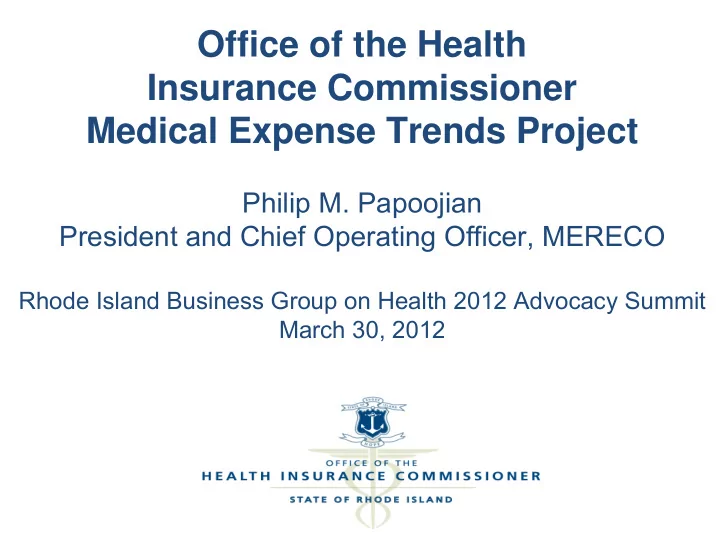

Office of the Health Insurance Commissioner Medical Expense Trends Project Philip M. Papoojian President and Chief Operating Officer, MERECO Rhode Island Business Group on Health 2012 Advocacy Summit March 30, 2012 Presentation to RIBGH March 2012
Health Insurance Advisory Council (HIAC) • Business, providers, consumers, and labor. Co- chaired by Commissioner Koller and William Martin • Advisory to the Office of the Health Insurance Commissioner (OHIC) • Monthly meetings • Recent accomplishments: Affordability Standards development, implementation, and monitoring and rate review process • http://www.ohic.ri.gov/Committees_HealthInsur anceAdvisoryCouncil.php 2
HIAC Medical Expense Trends Target Project • To develop a common understanding of how OHIC could define, set, and enforce a maximum medical expense trend factor(s) to be used as part of an annual commercial health insurance rate factor review process • To recommend whether such a methodology should be implemented by OHIC as part of its rate review process 3
Key Information Re: Medical Expense Trends • Medical expense trend is the projected increase in the costs of medical services assumed when setting premiums • It is composed of two factors: − Price of medical services − Number of medical services • Average Total Premium Change = Change in medical expenses + change in admin costs + change in reserves/profits • It is an average: Your premium increase may be higher or lower depending on your group’s changes in age, gender, family size, and claims experience (for large group) 4
What’s the Problem? RI Small Group Medical Expense Trend and PWC Medical Cost Trend 5
RI Large Group Medical Expense Trend RI Large Group Medical Expense Trend and PWC Medical Cost Trend 6
Lessons From Other States on Setting Trend Targets • Limited work by states so far on this topic. More on developing comprehensive rate review (we already have) and some discussion of payment reform • Discussion of formal targets or caps to trends adds to pressure: creates attention, reports and publicity (currently happening in Massachusetts—Governor Patrick) • Any effort should have clear standards for setting trends and flexibility to adjust • Any effort should have sufficient analytical resources and industry experience 7
What is the Objective for the Target? • From HIAC minutes: “The Council agreed that the target should both define (or at least outline) an affordable rate of increase (does not define affordable and does not necessarily accept all current costs) and force more serious actions by insurers and providers to change price and utilization patterns to achieve that target.” − The idea is that the system will not change without “turning the heat up” on insurers and providers 8
Options for Defining “Affordable Rate of Increase” • If OHIC’s charge is to address affordability, how should HIAC define affordability of medical expense trend? • Affordable definition options presented during the 1/17/12 meeting: ⎯ Wages ⎯ Economic production ⎯ Prices Medical prices? Non-medical prices? Producer prices? Consumer prices? • Governor Patrick (MA) as quoted on NPR on 2/14/12: – “I think we need legislation [so] that we don't continue to have increases above the rate of growth in the economy .” 9
CPI Comparisons Excluding Medical Care and Medical Care Only Compare this trend to current premium trends 10
How Should the Target be Set? Current thinking: Allow for possible base and reserve adjustments to the medical expense trend target – The Council has expressed concern that base premium rates be considered, relative to one another and to external benchmarks. Otherwise, high base costs could be “baked in” to future premiums. – Flexibility for OHIC is important because the assessment of base rate levels and of reserves does not lend itself to a simple computation, but rather demands an expert, individual insurer assessment. 11
How Should the Target be Set? Current thinking: Phase in the target (“a bridge”) over three years. OHIC would add a diminishing number of percentage points to the index-generated rate until reaching the target rate in Year 3. – Reducing medical expense trend to the index level will take considerable insurer effort and provider effort. Insurers are unlikely to be able to renegotiate contracts and make product changes within 12-18 months. So, too, are providers unlikely to be able to make sufficient care delivery changes within that time period. – This approach would provide immediate rate relief without creating dangerous disruption to the stability of insurers and providers. 12
Is the Target a Goal or a Requirement? What Are the Consequences for Exceeding it? • The medical expense target could be a goal or a requirement. • There are at least three options that can be considered: – Goal—with no specific consequences – Goal—with an automatic hearing at which provider rates and contracts and other cost drivers would be examined. – Requirement—with OHIC’s ability to adjust depending on the case made by an insurer 13
What are Some Issues to Consider with a Target? • Why do it? − The “system” is will not reform itself. It has not for forty years. It is necessary to turn up the heat on the system to create change. • Putting pressure on insurers with a target will put pressure on providers to take on new contracts and accept financial risk − What happens if providers won’t or can’t do this? − Is more direct accountability for providers necessary? • If a target is implemented—insurers will step up cost reduction activities (limited networks, prior authorizations, fee reductions). This will create turmoil. − Will employers support this? Or would you rather pay more? − RI employers have bought generous benefits and cautious benefit design (no managed care, no tiered networks). Why? • How long of a ramp down period − Too much—no relief for employers − Too little—too much turmoil for system 14
Next Steps • HIAC will continue to debate the issue • Collecting input from insurers and providers and purchasers • Refine the details • To be successful—this can’t be an OHIC/HIAC activity only. Are employers willing to support this? 15
Recommend
More recommend